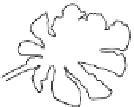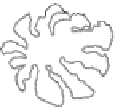Environmental Engineering Reference
In-Depth Information
Fig. 9.16
Relative
contributions of species
to ecosystem services
(species shown in order
of the size of their
contribution). (a)
Cumulative watermelon
pollination of 11 native
bee species in Califor-
nia. (b) Cumulative
contribution to carbon
storage of more than 40
tree species in tropical
rainforest at Chiapas in
Mexico. (After
Balvanera et al., 2005.)
(a)
(b)
100
100
80
80
60
60
40
40
20
20
0
0
0
2
4
6
8
10
0
5
10
15
20
25
30
35
40
Species rank
Species rank
live in neighboring patches of intact forest (Section 4.5.4). In the case of organic
watermelon farms close to intact forest, various species of native bee make a con-
tribution to pollination - calculated as the product of bee abundance and pollen
grains transported per individual. When ranked in order of contribution it becomes
clear that just one species is responsible for more than 60% of the pollination eco-
system service (Figure 9.16a). Knowledge of its niche and habitat requirements
would be paramount when countering any threats that may become apparent. Simi-
larly, between them the forest trees of a protected Mexican rainforest store about 94
tonnes of carbon per hectare. But just 13% of the tree species contribute 90% of
carbon storage (being more abundant and/or bigger and/or with denser wood)
(Figure 9.16b). An emerging threat to one or more of these key species (perhaps a
disease) could have a profound effect on the C-storage ecosystem service.
9.8.2
Ecosystem
health of forests -
with all their mites
Many ecosystems around the world have been degraded by human activities. Using
an analogy with the human condition, managers frequently describe ecosystems as
'unhealthy' if their community structure (species richness, species composition,
food web architecture), or their ecosystem functioning (productivity, nutrient
dynamics, decomposition rate), has been fundamentally upset by human pressures.
Aspects of ecosystem health are sometimes refl ected directly in human health. These
include nitrogen content in groundwater and thus drinking water, toxic algal out-
breaks in lake and ocean, and transmission of Lyme disease in oak forest fragments.
But any measure of ecosystem health must also refl ect whether valued ecosystem
services remain intact.
Management strategies c an be usef ully framed in terms of
pressure
(human action),
state
(resulting community structure and ecosystem functioning) and management
response
(Figure 9.17). Just as physicians use indicators in their assessment of human
health (body temperature, blood pressure, etc.), ecosystem managers need ecosys-
tem health indicators when prioritizing ecosystems for action and, just as important,
to enable them to determine whether their interventions have succeeded.
The Ponderosa pine forest (
Pinus ponderosa
) of the western USA illustrates the
relationship between pressure, state and response (Yazvenko & Rapport, 1997). A
variety of human infl uences are at play but the most important
pressure
has been
fi re suppression. Ponderosa pine forest evolved in a situation where periodic fi res
occurred naturally but, with human occupation, attempts to suppress fi re have
caused the
state
of the forest to shift towards lower productivity and higher tree








































































































































Search WWH ::

Custom Search